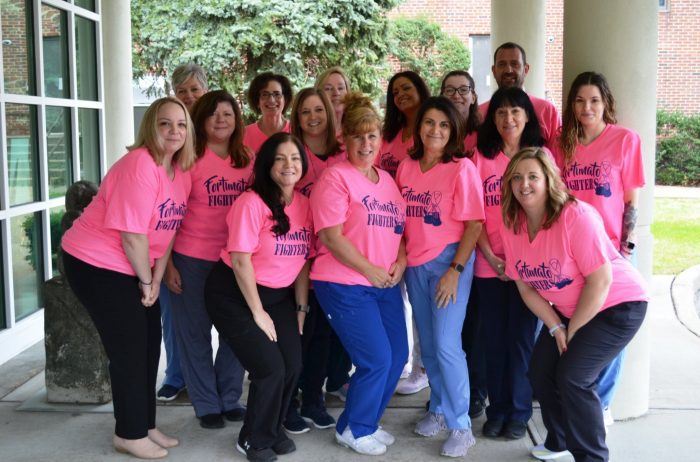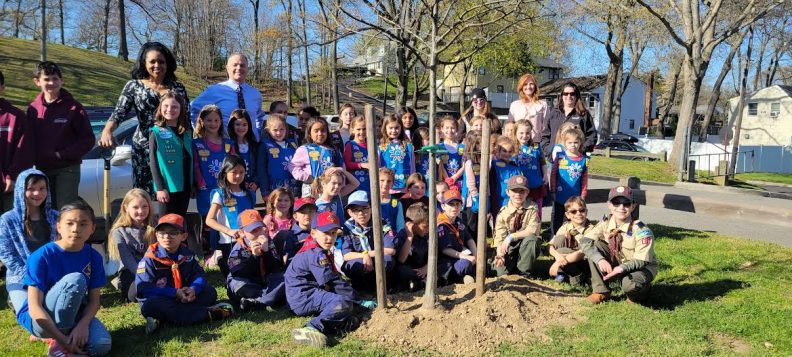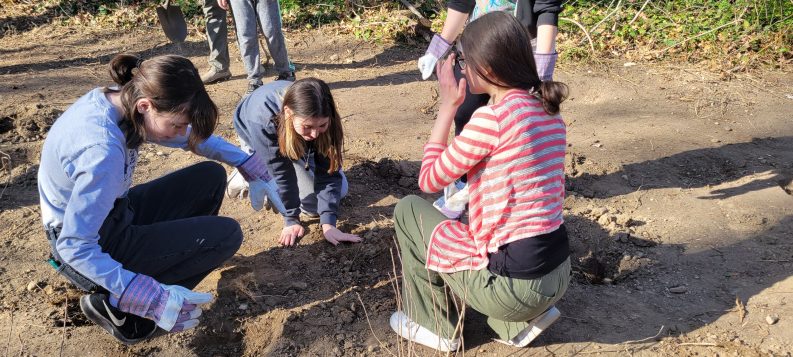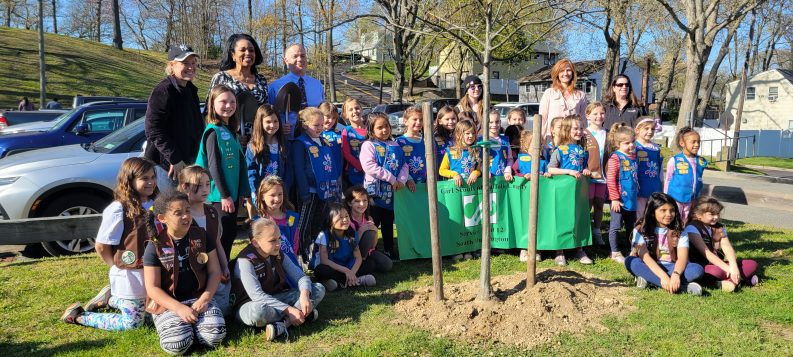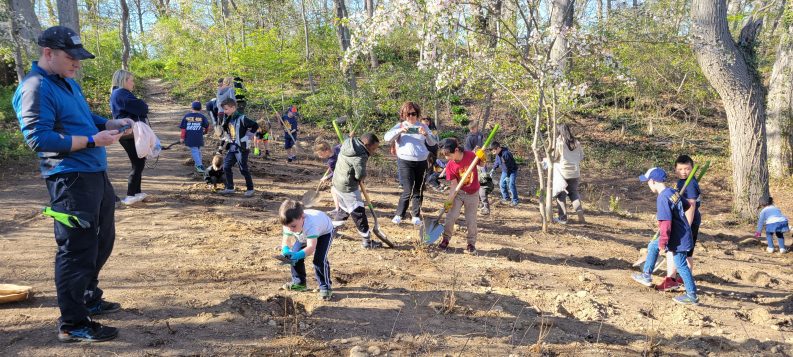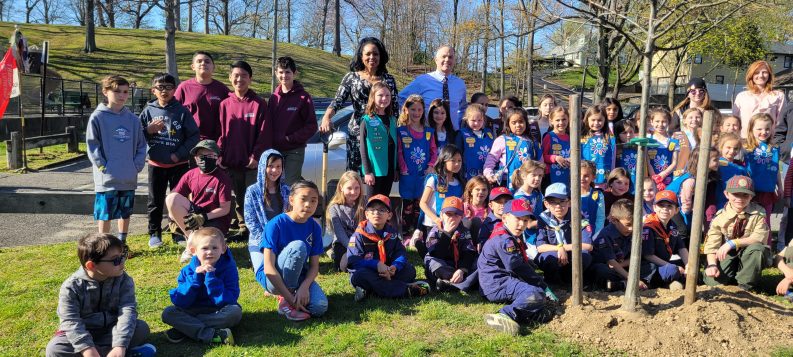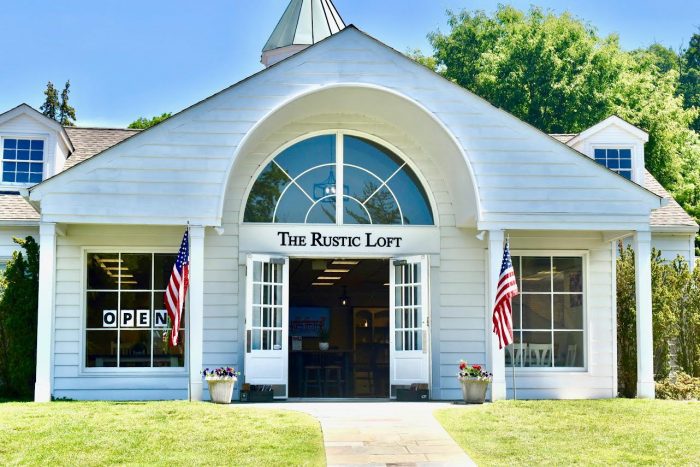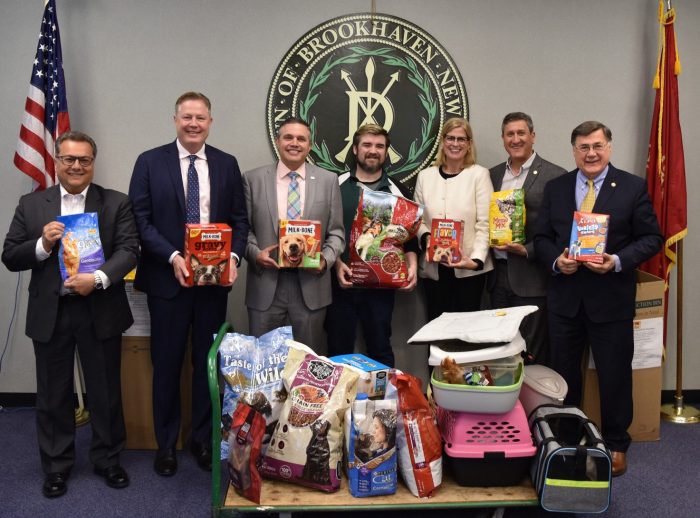In honor of Walk Week, Mather Hospital, 75 North Country Road, Port Jefferson will take part in the Northwell Health Walk on Sunday, May 22 at 10 a.m. The five-mile walk through Port Jefferson and Belle Terre will raise money for the Fortunato Breast Health Center. Registration opens at 8:30 a.m. with an opening ceremony at 9:45 a.m. Enjoy music by “Damaged Goods” and a light breakfast. To register to walk, form a team or donate, visit www.NorthwellHealthWalk.com/Port Jefferson.
Kids Korner: May 19 to May 26, 2022

PROGRAMS
Scavenger Hunt at the Hatchery
Celebrate World Turtle Day & Endangered Species Day with a scavenger hunt at Cold Spring Harbor Fish Hatchery, 1660 Route 25A, Cold Spring Harbor on May 20, 21, 22 and 23 anytime from 10 a.m. to 5 p.m. The Hatchery is home to some very unique animals. Some are even endangered, threatened or species of special concern. Take a hunt around to find and learn about these incredible animals. Admission is $7 adults, $6 seniors, $5 children ages 3 to 12. For more information, call 516-692-6768.
Cuddle and Care Workshop
Benner’s Farm, 56 Gnarled Hollow Road, East Setauket hosts a children’s workshop for ages 3 to 12, Cuddle and Care, on May 21 from 10 a.m. to noon, 12:30 to 2:30 p.m. and 3 to 5p.m., and on May 22 from 12:30 to 2:30 p.m. and 3 to 5 p.m. Children will be introduced to the farm’s newest baby barnyard animals. Learn what they eat, how they grow, and how to take care of them. There will also be a farm tour, crafts, and a tractor ride! $40 per child. To register, call 689-8172 or visit www.bennersfarm.com.
Tiny Seeds
Sunken Meadow State Park, Sunken Meadow Parkway, Kings Park hosts a Tiny Tots program for ages 3 to 5 titled Tiny Seeds on May 21 from 10:30 to 11:30 a.m. This program will connect children and their parents with nature through a short walk, animal visitors, and crafts. $4 per child. To register, please visit Eventbrite.com and search #NatureEdventure
Frogs & Friends
Caleb Smith State Park Preserve, 581 W. Jericho Turnpike, Smithtown presents a family program titled Frogs & Friends on May 21 from 10:30 a.m. to noon. From frogs and toads to newts and salamanders, amphibians are an amazing group of animals! Join the staff to learn more about these amazing cold-blooded creatures as you search for them in their natural habitat.$4 per person. Advance reservations required by calling 265-1054.
Beach Wander
Caumsett State Historic Park Preserve, 25 Lloyd Harbor Road, Huntington hosts a Beach Wander program for families on May 22 from 10 a.m. to 1 p.m. Take a walk to Caumsett’s beautiful north shore beach while learning about the forest, the Sound, the sand and the shells. Bring lunch and wear comfortable shoes. 5+ miles with hilly and sandy terrain. $4 per person. To register, please visit Eventbrite.com and search #NatureEdventure
Build-a-Boat Workshop
Come celebrate Maritime Heritage Day at the Whaling Museum, 301 Main St., Cold Spring Harbor on May 22. Adults and kids can drop in any time from 1 to 3 p.m. to imagine, design and create unique wooden vessel models out of a variety of materials in this open-ended workshop. Go home with your creation! Admission + $10 participant. Call 367-3418 for more information.
Owl Prowl Thursday
Visit Sweetbriar Nature Center, 62 Eckernkamp Drive, Smithtown on May 26 from 7:45 to 9:45 p.m. for an Owl Prowl! Meet and learn about some of the Center’s resident owls and then embark on a walk into the darkness to enjoy the night. Dress warmly, wear bug spray, and bring a flashlight just in case. Open to families with children ages 5 and up. $15 per person. For tickets, visit www.sweetbriarnc.org.
THEATER
Pinkalicious The Musical
The John W. Engeman Theater, 250 Main St., Northport continues its children’s theater season with Pinkalicious The Musical from May 28 to July 3. Pinkalicious can’t stop eating pink cupcakes despite warnings from her parents. Her pink indulgence lands her at the doctor’s office with Pinkititis, an affliction that turns her pink from head to toe — a dream come true for this pink loving enthusiast. But when her hue goes too far, only Pinkalicious can figure out a way to get out of this predicament. Tickets are $20. To order, call 261-2900 or visit www.engemantheater.com.
Snow White and the Seven Dwarfs
Theatre Three, 412 Main St., Port Jefferson presents Snow White and the Seven Dwarfs on May 28, June 4, 11 and 18 at 11 a.m. with a sensory sensitive performance on June 12 at 11 a.m. Join them for a hysterical retelling of a wonderful story with a Queen, a Witch, a Princess with skin as white as snow, and seven dwarfs guaranteed to keep you laughing from start to finish. Costumes encouraged. All seats are $10. To order, call 928-9100 or visit www.theatrethree.com.
Town of Huntington plants 200 trees at Koster Park for Arbor Day
Town of Huntington Supervisor Ed Smyth, Receiver of Taxes Jillian Guthman and Town officials were joined by Covanta and local students to plant 200 donated trees at Koster Park in Huntington Station for Arbor Day on April 29.
“It is so important to maintain our tree canopy; it adds shade, which reduces the need for artificial cooling, and it filters stormwater runoff to stop contaminants from entering our water supply,” said Supervisor Ed Smyth. “Thank you to Covanta and our anonymous donor, as well as the Girl Scouts, Boy Scouts and Huntington High School honor students for your dedication to preserving our green space, this is our largest Arbor Day turnout yet!”
“I’m proud to celebrate Arbor Day with Supervisor Smyth, many of our local Scouts, students and Covanta with the planting of trees at Koster Park, one of the many hidden jewels of Huntington,” said Receiver of Taxes Jillian Guthman.
“We are once again delighted to partner with the Town of Huntington and Supervisor Smyth to plant trees in honor of Arbor Day. Initiatives like this one are so important to preserving Long Island’s natural resources. We are grateful to our municipal leaders for joining with us as great environmental stewards,” said Maureen Early, Senior Community Affairs Specialist for Covanta. Joining the event from Covanta were Asset Manager Dawn Harmon and Shari Kleinman from the Covanta Huntington Facility.
Girl Scouts, Boy Scouts and students from the Huntington High School Honor Society helped plant bare root saplings at the park.
“Members of the Girl Scouts of South Huntington are honored to be a part of the Town of Huntington Arbor Daytree planting at Koster Park. The girls will expand their knowledge about caring for the environment, using resources wisely and making the world a better place,” said Catherine Galli, Coordinator for Girl Scouts Service Unit 12 in South Huntington, who was joined by Troop Leaders Christine Reilly, Bonnie Millman, Kristie Mondo, LeeAnne Ramirez and Wendy Aull with Girl Scouts from Service Unit 12, including Junior Troop 161, Daisy Troop 32 and 74, and Brownie Troop 703 to help plant bare root saplings.
Boy Scouts Troop 34 Scoutmaster Mike Fasciano and Assistant Scoutmaster Dominic Dutton were joined by Boy Scouts from Troop 34 for the tree planting.
“The Cub Scouts are all about having fun with a purpose,” said Scott Wallick, Cubmaster for Pack 406 of South Huntington. “There is a reason for everything our boys and girls do in Cub Scouting, and today’s events will help them ‘think globally’ and ‘act locally’ to preserve and improve our environment. We are grateful to have been a part of the Town of Huntington’s Arbor Day tree planting.” Cub Scouts Pack 406 Assistant Pack Leader Jennifer Rodriguez was joined by Cub Scouts from Pack 406 to plant trees at the event.
Joining the event from the Town’s Department of Planning and Environment to teach the students about the trees and demonstrate how to plant the bare root saplings were Christian Granelli, Elana Israel-Edgar, Dave Kaufman and Vincent Cerniglia.
From the Department of Parks and Recreation, Director Todd Jamison and Deputy Director Walter Edwards joined the event with Town Volunteer Parks Stewards David Lesser and Christopher Zonin.
The ceremony involved the planting of a Caliper Pin Oak donated by Covanta and 200 additional bare root saplings consisting of 25 each of Flowering Dogwood, Highbush Cranberry, Buttonbush, Ninebark, Black Chokeberry, Virginia Rose, Witch Hazel, and Winterberry donated anonymously to the Town of Huntington to commemorate Arbor Day; the Town Board accepted the donations at their April 12 meeting.
PSEG-LI to discuss energy costs at Three Village Chamber meeting May 18
Are you a local business interested in learning more about ways to cut-back on energy costs? The Stony Brook Village Center will be hosting a Three Village Chamber of Commerce breakfast at the Rustic Loft sponsored by PSEG-LI at 8:15 a.m. on Wednesday, May 18 to discuss the rebates and grants available to small business, commercial, industrial, educational and municipal customers.
A panel of PSEG-LI officials will discuss rebate categories such as lighting, outdoor lighting, refrigeration, heating, ventilation and air conditioning, water heating and conservation, geothermal energy, green building, and more. Also to be discussed is the PSEG Main Street Revitalization GRANT Program, a program designed to encourage economic vitality of a business district and to optimize the use of existing electric infrastructure.
The Rustic Loft is located at 97K Main Street in Stony Brook Village Center.
You do not need to be a member of this Chamber of Commerce to attend this meeting. $20 per person, includes a full breakfast. Registration is required. To register, click.HERE or visit the Three Village Chamber at www.3vchamber.com.
Brookhaven Town collects pet food and supplies for Long Island Cares
Brookhaven Town collected 360 lbs. of pet food and supplies during the Long Island Cares 11th annual Legislative Pet Food Drive Challenge. This drive focused on collecting and providing food for the family members most vulnerable to hunger – our pets. This year, the Town accepted donations at seven drop off locations from March 21 through April 22. Donated items included canned dog and cat food, five to ten-pound bags of dry food, treats and various pet care supplies including litter boxes, food bowls, pet carriers, pet toys and more.
Pictured from left are Councilman Michael Loguercio; Councilman Neil Foley; Councilman Kevin LaValle; Long Island Cares – The Harry Chapin Food Bank Food Drive Manager, Billy Gonyou; Councilwoman Jane Bonner; Councilmember Jonathan Kornreich and Supervisor Ed Romaine.
Paw Prints: Meet shelter pets Keesha, Snowflake, Chelsea, Ophelia, Jack Jack!
 Welcome to the fifth edition of Paw Prints, a monthly column for animal lovers dedicated to helping shelter pets find their furever home!
Welcome to the fifth edition of Paw Prints, a monthly column for animal lovers dedicated to helping shelter pets find their furever home!

Meet Keesha
This adorable and sweet girl is Keesha. She was surrendered to the Brookhaven Animal Shelter because her family was no longer able to care for her. Keesha is a gentle soul who has to start over at the age of 10. She is as sweet as could be, she knows sit but is always checking out her surroundings to see who is available to get some pets from. She is looking for a family to love, a door to look out of and get her daily dose of sunshine and a bed to curl up in. She is a delight to walk, she is housebroken and would love the opportunity to show you what she is made of. She can be a little shy at first but then the happy go lucky girl comes out and she is giving kisses and looking for all of your attention. She would do best with kids over the age of 10, no dogs and she is fine with cats. Call 631-286-4940.
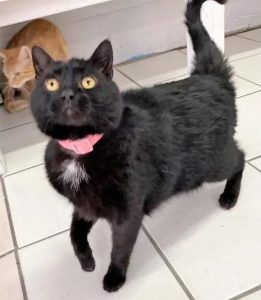
Meet Snowflake
Snowflake is a young adult, female, short-hair currently waiting at Little Shelter for her furever home. This patient, sweet girl that had been at the shelter since 2018. She gets overlooked because she likes to snuggle into cubbies. Laser toys are a great way to get her out and about! Call 631-368-8770.

Meet Chelsea
An eight-year-old Min Pin mix, this clever little lady is Chelsea, currently up for adoption at Little Shelter in Huntington. Subscribing to the adage that all you need is “a snack and a snuggle,” she’s the perfect one to share your couch with…and just about everything else! A breed that has been described as “tiny but mighty,” they have an outgoing personality and tenacious spirit. With her current mission being to find her forever home, Chelsea is ready to screen potential adopters, hoping to find her the perfect family. Energetic and self-possessed, she’s not about to let age slow her down. If you’re looking for a loyal, life-long friend with a good sense of humor, the search is over…just ask for Chelsea. Call 631-368-8770.

Meet Ophelia
“Hi, I’m Ofie from Kent Animal Shelter. It’s going to take a little while for you and me to become best friends and trust each other. But, I promise you that when we do, you will be showered with more love, affection and loyalty than you can imagine. There is nothing more that I love than hugs, kisses and belly rubs
just ask the kind people who work here at the shelter. But sometimes, new people make me nervous, and I get a little scared and I feel I need to protect myself because I am not sure yet who you are. You see, I came to America from the streets and meat markets of Thailand., and some people there were going to do really bad things to me. That’s why it may take a little while for you and me to become best friends
.but I promise it can happen if you give me a chance. Thank you for reading a little about me. I hope to see you soon. Oh and I love treats! Love, Ofie.” Ophelia needs to be the only pet in the house. Call 631-727-5731, ext. 1.

Meet Jack Jack
“A dog so nice, he was named him twice!” Jack Jack, a 1.5-year-old Doxy mix, arrived at Little Shelter hoping for a second chance at happiness. Though nearly blind, he is quickly acclimating to his surroundings, sniffing out new friendships and hearing all the applause celebrating his progress. Playing with abandon despite his disability, he’ll teach you to grab life by the tail, take chances, and savor every moment. Smart, affectionate and loyal, Jack Jack is the perfect reminder that “a house is not a home without paw prints.” Stop by to meet him today! Call 631-368-8770.
 Kitty Free-Fur-All
Kitty Free-Fur-All
May is Kitty Free-Fur-All Month at the The Town of Brookhaven Animal Shelter and Adoption Center, 300 Horseblock Road, Brookhaven. Fees will be waived for cat adoptions for the entire month. For more information, call 631-451-6955 or visit www.brookhavenny.gov/animalshelter
Check out the next Paw Prints in the issue of June 9.
Paw Prints is generously sponsored by Mark T. Freeley, Esq.
Cooking Cove: April showers bring May flowers and more spring recipes
By Barbara Beltrami
I warned you a couple of weeks ago that you shouldn’t be surprised to find yet another column with recipes for spring. How can I do otherwise with the world in bloom at my doorstep? The split pea soup has given way to a creamy fresh pea soup, an artichoke frittata seems just the thing for a Sunday brunch or light lunch, and the sorrel in my herb garden is begging to be cut for a sorrel sauce for salmon.
Fresh Pea Soup
YIELD: Makes 4 servings
INGREDIENTS:
2 tablespoons unsalted butter
1 medium onion, minced
1 leek, trimmed, washed and thinly sliced
Salt and freshly ground pepper to taste
2 tablespoons flour
4 cups chicken broth
1 1/2 pounds fresh or frozen peas
1/2 cup heavy cream
DIRECTIONS:
In a large saucepan melt butter over medium heat, then reduce heat to low and add onions, leeks, salt and pepper. Cook, stirring occasionally, until soft but not browned, about 6 to 8 minutes.
Add flour and stirring with a whisk, cook for two minutes; slowly add broth and still stirring with whisk over medium heat, bring to a simmer. Add peas and simmer for 7 to 9 minutes. Let cool 10 to15 minutes, then puree in blender or food processor until smooth. Return to saucepan, add cream, and stirring frequently, bring to a brief simmer over medium heat. Serve hot or warm with croissants.
Artichoke Frittata
YIELD: Makes 6 to 8 servings
INGREDIENTS:
1 pound fresh baby artichokes, trimmed
8 large eggs
2 tablespoons half and half
Salt and freshly ground pepper, to taste
1/4 cup extra virgin olive oil
1 shallot minced
1/4 cup minced fennel, bulb and fronds
2 tablespoons freshly grated Parmigiano cheese
DIRECTIONS:
Steam or boil artichokes in salt water until tender, then drain and rinse with cold water and cut into quarters. In a medium bowl, vigorously beat the eggs, then add half and half and salt and pepper. In a nonstick skillet with a metal handle heat oil over medium-high heat; add shallot and fennel and cook, stirring frequently, until they soften, about 3 to 5 minutes.
Add artichokes and cook, stirring frequently, until they just begin to brown; pour in egg mixture and swirl pan to distribute mixture and veggies evenly over surface; tilt pan and gently lift edges of cooked egg mixture as you swirl in order for liquid to run underneath cooked part. Reduce heat to low, cover pan and cook another 6 to 8 minutes occasionally shaking pan back and forth so frittata doesn’t stick to bottom of pan but just starts to brown.
Meanwhile preheat broiler. Leaving the oven door slightly ajar, place skillet under broiler for a minute or two to finish off center of frittata which will still be runny. Be vigilant! Using a potholder for the metal handle, remove from oven, flip onto serving plate and sprinkle with grated cheese. Serve hot, warm or at room temperature with a mesclun salad.
Salmon with Sorrel Sauce
YIELD: Makes 4 servings
INGREDIENTS:
Four 1/2 pound salmon filets
1/4 cup unsalted butter
2 cups fresh sorrel leaves, chopped
1/4 cup chervil, finely chopped
1/4 cup fresh flat leaf parsley, finely chopped
1/2 cup chives, snipped
1/2 cup heavy cream
Salt and freshly ground pepper to taste
Chive flowers for garnish
DIRECTIONS:
Poach or broil salmon until just starting to turn light pink in center; set aside to keep warm. In a large skillet over medium-high heat, melt butter until golden brown. Lower heat to medium and add sorrel, chervil, parsley and chives, stir just until they’re wilted, then add cream, salt and pepper. Bring to a boil, then reduce heat and continue to cook, stirring frequently, until the sauce is thick enough to coat the back of a spoon. Spoon sauce over salmon. Garnish with chive flowers. Serve hot or warm with fresh asparagus and boiled new potatoes.
A year later, Stony Brook University LEND trainees reflect on lessons learned
By Daniel Dunaief
Bringing together people from a range of experiences and perspectives, Stony Brook University is preparing to complete the first year of its LEND training program, which is designed to help provide support and services for people with autism and neurodevelopmental disabilities.
Over 100 trainees will complete the course this month, as the leaders of LEND, which stands for Leadership Education in Neurodevelopmental and other related Disabilities, prepare to educate a second year of participants that is expected to exceed 300 people.

2nd row: Pallavi Tatapudy, Isaac Rodriguez, Morgan McNair
3rd row: Sarah Grosser, Anjolie Nagarwalla, Jenny Andersson
Bottom row: Christopher Rosa, Ava Gurba
Matthew Lerner, LEND Center Co-Director, Research Director of the Autism Initiative, and Associate Professor of Psychology, Psychiatry & Pediatrics, and Michelle Ballan, LEND Program and Center Director, Professor, and Associate Dean for Research in the School of Social Welfare and Professor of Family, Population and Preventive Medicine, run the program, which is the first on Long Island to receive a federal grant that supports training students, families, professionals and self-advocates.
Lerner described three key takeaways for the $2.2 million, five-year grant.
First, “if we want to be effective in supporting individuals with neurodevelopmental disorders we have to be interdisciplinary,” he said.
Second, the group, which includes trainees at three different levels depending on their time commitment to the program, needs to “listen to the voices of autistic people,” Lerner added. For too long, “they’ve been an afterthought at the table of care.”
Third, the work is a “process and not an outcome,” he said.
Many of the participants in the program appreciated the opportunity to engage in an interdisciplinary effort.
Self-advocate
Ava Gurba, a self-advocate and master’s student at Stony Brook University who has autism and cerebral palsy, said she saw LEND as her chance to “reframe the professional discipline” and inform people in a range of fields about what life is “really like” for her and others.
Many professionals in health care have limited experience working with self-advocates.
“They have only interacted with disabled people as clients in a therapeutic setting or as research subjects,” Gurba said.
Researchers and service providers don’t often know how to incorporate the lived experience for the family and from self- advocates, she added.
Gurba suggested that some professionals need to “unlearn” practices that don’t incorporate the values and needs of people with disabilities.
The medical community is often looking for cures, while Gurba said she and others with disabilities are more often looking for ways to be integrated into the community, through social, employment, or educational opportunities.
Clinical training
For Alan Gerber, a doctoral student in the Department of Psychology at Stony Brook, LEND provided autism-specific clinical training, including planning treatment and reviewing the progress for specific patients.
“It gives me an opportunity to get together with an inter-disciplinary cohort and see things from a different lens,” Gerber said.
Gerber plans to be a clinical researcher and will conduct post doctoral research at the Yale Child Study Center.
LEND “made me think very deeply about what is clinically meaningful research,” Gerber said. When he speaks with families, pediatricians and social workers, he wants to do the kind of research that is “really going to change a family’s life.”
Gerber hopes to remain in contact with other members of the LEND community, where he felt he was part of a team.
Paradigm shift
As a high school bilingual speech language pathologist who works closely with individualized education plans, Jenn Solomon wanted to understand more about the lives and challenges of people with developmental disabilities.
LEND provided a paradigm shift for Solomon in helping her understand disability. “I can listen to what people with disabilities have to say, and I can reflect and learn,” Solomon said.
One of Solomon’s broader goals is to advocate on behalf of students who have obstacles to overcome.
Jenny Andersson, who works for the New York State Department of Education Office of Special Education funded project called the Educational Partnership, suggested that LEND “exceeded what I had imagined.”
Like other trainees, Andersson, who is Director of the Early Childhood Family and Community Engagement Center, appreciated the participation of self-advocates.
“I approach everything in my work now and ask, ‘Did we invite all stakeholders to the discussion?’”
Ripple effects
Andersson is excited to see the ripple effect of the program, where other professionals benefit from what trainees learn and discuss and change their practices.
Indeed, Dr. Pallavi Tatapudy, a second-year psychiatry resident at Stony Brook, said her husband Nishank Mehta, who is a first-year orthopedic surgery resident at Stony Brook, has learned about advocacy from some of the discussions she had through LEND.
“This experience of working together and hearing all of these personal insights, you cannot get from a textbook,” Tatapudy said.
Tatapudy understands the value of consulting with people who have disabilities and with their families. “The patient is the expert,” she said.
When she worked in the inpatient psychiatric unit on the 12th floor of Stony Brook Hospital, Tatapudy said she spoke to a family who was admitting a child with a neurodevelopmental disability. She asked parents for an idea of ways to comfort their child that de-escalate emotionally charged moments at home. His parents said a particular blanket from home provided comfort, which they brought to the hospital.
Tatapudy is “proud” that Stony Brook is a LEND center, joining 60 others throughout the country.
For Lerner, who was a LEND trainee about a dozen years ago and continues to stay in touch with his LEND cohort, the effort helps experts learn from each other and from self-advocates who can share their perspectives. “None of us has enough expertise to do this alone,” he said.
Nature Matters: Alewives and Eels – Part 2
By John L. Turner
This is part two of a two-part series on a remarkable pair of fish.
The life cycle of the American Eel is a bit more complicated than river herring and consists of six stages: egg, larvae, glass eel, elver, yellow eel, and silver eel.
Mature adults reproduce just once in their lifetime with all the eels emanating from the East Coast unerringly migrating to the Sargasso Sea where mass spawning takes place. (The Sargasso Sea, situated south of Bermuda, has no land borders but is distinct by being bounded by four strong ocean currents, including the Gulf Stream, resulting in quiet waters entrained within the gyre; here masses of sargassum weed abound giving shelter to many marine species including hatchling sea turtles).
Shortly after spawning here the adult eels die. A grown eel releases as many as several million eggs and they hatch within a week. At first the leptocephali don’t look eel-like, being transparent and flattened, described as looking like a willow leaf; they are carried north by the currents, including most notably, the Gulf Stream.

After about half a year they metamorphose into “glass eels,” still transparent but shaped like baby eels, and this is the stage, along with the slightly pigmented elver stage, that arrives at the mouths of Long Island’s streams. They wriggle their way up vertical faces and over wet land to make their way into freshwater ponds and lakes (although some spend their adult lives in brackish waters of Long Island’s estuaries).
While living for decades in ponds and lakes they move through a few more color stages, including yellow and silver eels. Here they become fully integrated members of the local food web, feeding on a variety of different aquatic prey while being preyed upon by many other animals including ospreys and bald eagles (stay tuned: June’s “Nature Matters” column!).
Eels are also food for humans (remember one of Long Island’s most famous paintings — William Sidney Mount’s 1845 “Eel Spearing at Setauket”?). Eventually some internal trigger “tells” these decades-old fish to head to the ocean and back to the Sargasso Sea to create a new generation of eels. To assist them in their long journey their bodies change a little — their eyes enlarge as do their pectoral fins.
Eel are managed by the Atlantic States Marine Fisheries Commission (ASMFC), beginning in 2006 with the first species management plan. The Commission sets harvest quotas for all age classes of eels including those to be used as bait and for direct consumption. The news has not been good over the past several decades with eel abundance on the decline and ASMFC currently classifies the eel stock as “depleted.”
Ways to increase abundance? Reduce all causes of eel mortality, especially among younger animals, among adults trying to navigate the perils of turbines at hydroelectric dams and increase opportunities for eels to migrate to freshwater areas where they can survive, becoming mature adults through time.
The Seatuck Environmental Association has been at the forefront of documenting the migratory occurrences of Long Island’s alewives and eels through its signature river herring and eel surveys and has, for decades, been working to protect existing runs while facilitating others. If you want to participate in trying to find new sites of alewife runs or eel migration or document more completely whats’s happening at existing sites, go to Seatuck’s webpage.
In pre-colonial times, before the advent of dams and other obstructions, many, if not all, of Long Island’s streams and rivers likely teemed in Spring with alewives and eels. They, in turn, provided nourishment to many species of wildlife from otters to ospreys to eagles. However, the Long Island of today is a very different place, with so many ecological threads severed or frayed. The reduced abundance of these fish illustrate the pervasive loss of ecological connectivity that has occurred on Long Island in the past few centuries. The good news? Many individuals, organizations, and governmental agencies are working to enhance connectivity here – to reconnect severed ecological threads – through the installation of additional ladders and passageways, and better yet, the removal of more dams, all steps to give these remarkable animals a chance to recover and perhaps even prosper.
I hope you make their acquaintance.
A resident of Setauket, John Turner is conservation chair of the Four Harbors Audubon Society, author of “Exploring the Other Island: A Seasonal Nature Guide to Long Island” and president of Alula Birding & Natural History Tours.
Attorney At Law: Myths surrounding probate
By Nancy Burner, Esq.

The legalities surrounding a Last Will and Testament stem from Roman times, when six witnesses affixed their personal seals to a will. The will was later validated by examining these seals to make sure they remained intact.
Today we use staples instead of seals, but, because the probate process remains so formal, many misconceptions exist. Let’s discuss some of the more prevalent myths surrounding probate that we encounter.
Myth: If I have a will, my estate doesn’t have to go through Probate.
While a will documents where your assets go at death, a will does not avoid probate. Probate is a Surrogate’s Court proceeding whereby a decedent’s Last Will and Testament is validated and given effect.
In New York, a will is admitted to probate after the Executor files a petition. The probate petition includes the original will, as well as a death certificate and funeral bill. Proper notice must be given to the individuals who would have inherited had the decedent died without a will.
The court issues “letters testamentary” which give the executor the authority to act. The executor opens an estate bank account, pays the debts of the estate and then makes distributions to the beneficiaries.
The only way to avoid probate is to place all assets into a trust or die owning only “non probate assets.” Non-probate assets are those held jointly or that list beneficiaries. Common non-probate assets with beneficiary designations are retirement accounts and life insurance policies. Not all types of accounts allow designated beneficiaries or transfers on death. Naming others as joint owners can have catastrophic drawbacks, such as capital gains tax and creditor issues. A revocable trust is the gold standard in avoiding probate.
Myth: I don’t need a will because my spouse will inherit everything.
The only way your spouse inherits everything is if you do not have children or grandchildren. People are often surprised to learn that if they have children, their spouse does not inherit all their assets.
In New York State, if someone is married with children and dies without a will, their spouse gets the first $50,000 and half of the remaining assets. The children split the other half amongst themselves. This means that without a will, minor children or children from a previous marriage inherit almost half of your assets.
This is not what most people expect or want. The only way to make sure your spouse inherits 100% of your assets is to draft a will or trust.
The probate process can be avoided if the couple owns all assets jointly. Joint ownership has its own problems — especially considering estate taxes or if there are children from a previous marriage.
The probate process may sound confusing, but the procedure is easy and orderly with the help of an estate attorney. One of the kindest things you can do for your family is to draft a well-thought-out estate plan so that your assets pass in an orderly manner. At Burner Law Group, we charge flat fees so that clients fully understand their options and receive an estate plan custom tailored to them.
Nancy Burner, Esq. is the founder and managing partner at Burner Law Group, P.C with offices located in East Setauket, Westhampton Beach, New York City and East Hampton.


